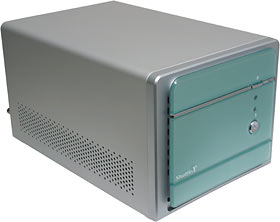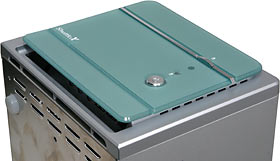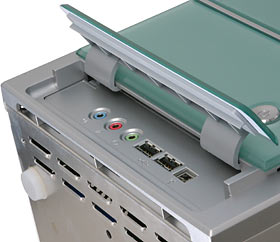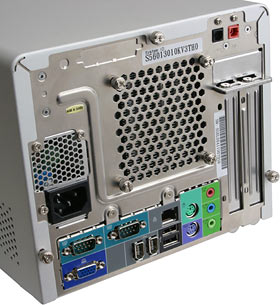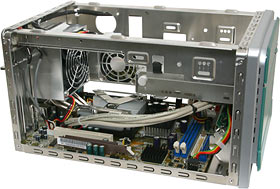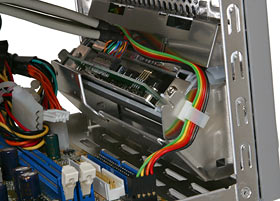
Shuttle SS56L Limited Edition
Review date: 23 April 2004. Last modified 03-Dec-2011.
Shuttle are no longer interested in merely making little tiny PCs.
That, they've pretty much mastered already. Their range of toaster-sized bare bones boxes (add your own standard desktop CPU, RAM and drives) are about as small and light as they can get without becoming a pain to work on, have got plenty of stuff built in, and come with various motherboards that make them suitable for all kinds of applications. All Shuttle's "XPCs" lack is expandability, but most people don't need six PCI slots and eight drive bays these days - not with the amount of built-in bits the XPCs provide.
What Shuttle now seem to be doing, while they wait for more big-computer features to be invented so they can stuff them into their tiny machines, is showing off.
Case in point.
This is the Shuttle SS56L Limited Edition. Functionally, it's much the same as various other little Socket 478 (P4 and Celeron) Shuttle boxes, and similar products from the other manufacturers competing in the full-desktop-performance segment of the "Small Form Factor" market.
The SS56L is just prettier than most.
Shuttle have come up with several particularly cool-looking XPCs, not least of which is the not-for-the-tweaker-market XPC Zen. The SS56L has ticks in a lot more performance-feature boxes than the Zen, but manages to look even cooler, in its own way.
Here in Australia, Aus PC Market sell the SS56L for $AU489.50 including Sydney metro delivery - delivery elsewhere in the country costs more.
The SS56L is, I'm told, "styled to be digital". This maintains the high standards of informative journalism we've come to expect from marketing people.
Outside and in
The SS56L's front panel stands proud of the actual front of the chassis, and there are small air inlets around its edges, and a big one at the bottom. Well, most of the time.
The SS56L, you see, has an unremarkable suite of front panel connectors (audio, two USB, one mini FireWire), but they're mounted on a hinged, um, thingy. When you pull the bottom part of the front panel out, the ports swing into place. When you close the front panel again, the ports swing back and leave a sizeable air inlet hole where they were - as well as letting the the devices you've plugged in stay plugged in, as long as their cables don't mind turning out through the gap under the hinged panel.
There's no filter on the gap at the bottom, inlet, mind you, and it's down at the bottom of the front panel, so I wouldn't be at all surprised if SS56Ls that live on the carpet get rather dusty inside. And there are, to tell the truth, plenty of vent holes down the sides of the case; I don't know how much the SS56L needs another vent.
But c'mon. It's cool.
The top of the front panel hinges, too; it's a "stealth" cover for the optical drive of your choice, with a neat little adjustable pusher arrangement that should let you operate the eject button of any drive by using the shiny button on the front of the case.
Notably missing from the SS56L's front panel, though, is any place to put a floppy drive. If you want one, you're meant to buy a USB one.
Amusingly enough, the motherboard inside the SS56L actually does have a standard floppy connector on it, though. The power supply's got a floppy plug, too, though it's no doubt meant to be used to power high-end video cards. In a pinch, though, you could plug a regular floppy drive into an SS56L; you'd just have to do it with the casing off and sit the bare drive next to the computer.
Even more mystifyingly, the SS56L's PSU also has a Serial ATA power plug. There are no Serial ATA ports on the motherboard, though, so it beats me what it's doing there.
The SS56L's back panel is quite ordinary Shuttle fare. Which is to say, it's got pretty much everything most people need, all built in.
Optical digital audio in and out, standard audio and PS/2 mouse and keyboard connectors, 100BaseT network socket, two full-size FireWire 400 sockets, two nine pin serial ports (presumably because they had the space to spare) and a standard HD15 monitor socket.
And two expansion slots waiting for a card. As usual for two-slot Shuttles, one slot's PCI and the other's AGP, so you can install a regular AGP video card if the motherboard's built in video doesn't please you.
The back panel is dominated by its central exhaust fan grille; like other full-desktop-power Shuttles, this one makes as much noise as any other regular desktop computer. The rear fan draws air through the case and cools the CPU, thanks to one of those clever heat pipe coolers that Shuttle have been putting in lots of their products lately.
Undo the three thumbscrews holding the casing on and you're rewarded with one of Shuttle's usual well-filled, yet reasonably accessible, interiors.
One Socket 478 lurking under the heat pipe cooler, two RAM slots (each of which can take up to a 1Gb module), two standard Parallel ATA drive connectors (each capable of controlling the usual pair of drives; good luck finding somewhere to put four drives in this box), and a bunch of pre-connected cables (not having to fiddle with case switch and light and port leads is one of the definite plusses of buying a bare-bones box).
The 3.5 inch bay for the hard drive is removable; it's retained by one screw, and swings out in typical Shuttle clever-clogs fashion. It feels flimsier and is more awkward to remove and replace than the usual XPC drive bays, but it's good enough. You don't need much metal to hold just one drive. There's a clear plastic cable clip under the bay, to help keep the ATA lead out of the airstream.
Here's the front port assembly in its hinged-up, closed position. Really, I don't think the functionality it provides really justifies this degree of mechanical detail, but it is cool, and it's tidier than the usual kind of fixed front panel ports. The assembly seems solidly made, too.
The giblets
The SS56L has Shuttle's FS56 motherboard inside, powered by the SiS 661FX chipset.
"SiS" used to translate as "Run! While you still can!" for performance PC enthusiasts, but the 661FX is actually a more than adequate base for any current Pentium 4 (or Socket 478 Celeron) system. It's not up there with the very speediest P4 chipsets, but if you're not told about the difference you're unlikely to notice.
The 661FX's chief shortcoming is that it only supports single channel DDR RAM, not the dual channel memory all the hip kids are using these days. So you're not going to be able to wring as much performance out of it as top-end Socket 478 boards can manage. RAM bandwidth doesn't actually have much impact on most desktop PC tasks, though, so single channel memory ain't a big deal, really.
SiS are proud of the "HyperStreaming" and "Ultra-AGPII" features in the 661FX, but they don't amount to much.
HyperStreaming is basically just another marchitecture buzzword. Yes, it does actually mean something, and it helps SiS's Dual DDR motherboards get right up there and mix it with the best Intel can produce, but PC benchmarkers are used to having to seriously stretch their graphs' scales to show real performance differences between even very different chipsets. We're not talking chalk and cheese, here.
Ultra-AGPII, in turn, only affects the bandwidth to and from the 661FX's "Real256E" integrated graphics adapter. By connecting the adapter to system RAM faster, it slightly reduces the frequency and enthusiasm with which the Real256E sucks the flatulence out of deceased ursines, without changing the basic fact that it does.
The Real256E is, you see, the same thing as the earlier Real256, except running at 200MHz instead of 166MHz, and the 3D performance of all Real256 variants may safely be described as miserable. The Real256 beats Intel's isn't-this-name-false-advertising "Extreme Graphics 2" for some tests and doesn't for others, and the Real256E should do a bit better, but it still doesn't approach the speed of current-generation budget standalone 3D cards. The Real256E isn't even vaguely interesting if you want to play any 3D game much younger than Quake 2.
This is perfectly all right, though. The Real256E has ample 2D performance (every graphics adapter for years has been fine for 2D), which is all many users need. If you're a gamer, there's that AGP slot waiting.
If you're an overclocker, the SS56L also has you covered. It's got CPU, RAM and AGP voltage control, RAM timing tweaking, CPU-to-RAM clock ratio setting (1:1, 3:4, 3:5, 1:2), and CPU FSB adjustment up to a hey-it's-possible 232MHz.
That's only a 16% overclock for an 800MHz-FSB P4 (the actual stock FSB clock for one of those is 200MHz; the 800MHz number comes from "quad-pumping" the bus to get four data transfers per clock tick), but now that the legendary-for-about-three-months P4 2.4C sinks into memory and 2.8GHz becomes the slowest P4 many stores have on their shelves, 15-odd per cent is about all the overclock you're likely to be able to get.
Recent SiS-chipset motherboards with decent overclocking options (many SiS-based boards have overclock-free BIOSes) have generally been performing well, so the SS56L ought to be pretty crankable, too.
As usual, though, you shouldn't assume you'll be able to crank your old 2GHz P4 to 3GHz, or get any overclock to speak of out of a P4 Celeron, and complain when you can't. If it happens, it's a free gift. If it doesn't, you're still going to have a computer that's fast beyond the wildest dreams of people a couple of years ago. Deal with it.
Overall
If you want a distinctly different looking small form factor box, the SS56L could be what you're looking for. Its slick looks don't mean a lack of features or a disturbingly high price tag, its SiS chipset gets the job done, it's got all of the portability advantages of every other SFF box, and its front panel opens up in interesting ways. The open, plug, close-and-hide design of the front panel is genuinely new, and I think it actually ought to work pretty well; cables snaking out from under the closed panel certainly look better than a bunch of exposed ports with plugs in 'em.
Heck, you can even plug in a 34-wire floppy, if you don't mind having the thing prolapsing out of the side of your computer.
My SFF needs are filled for now, but if they weren't, I'd be quite happy to buy an SS56L. Recommended.
Buy stuff!
Aus PC Market don't sell the SS56L any more, but you can check out their
current Small Form Factor boxes on their
Combos page!
(If you're not in Australia or New Zealand,
Aus PC Market won't deliver to you. If you're in the USA, try a price search
at
DealTime!)
